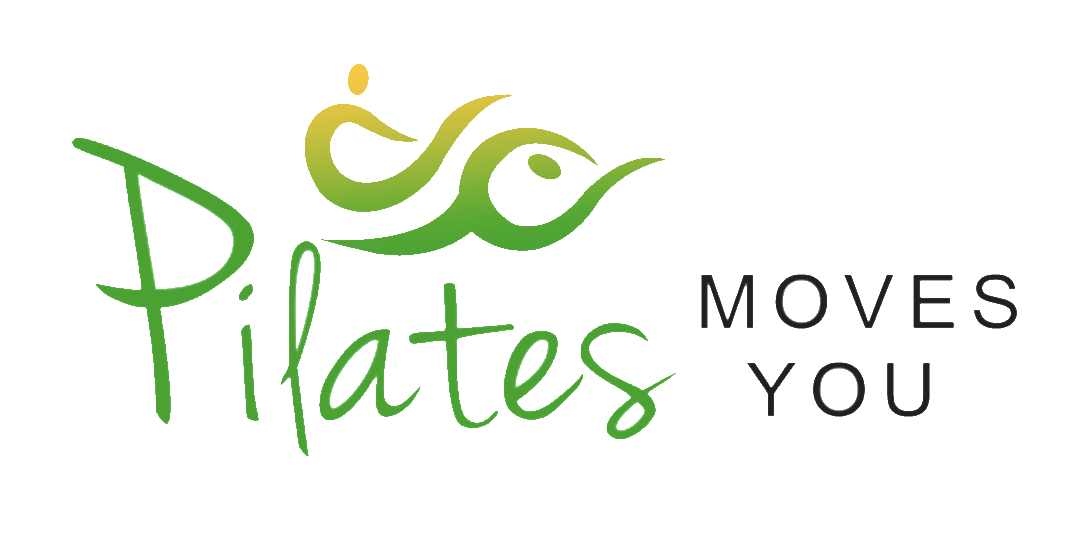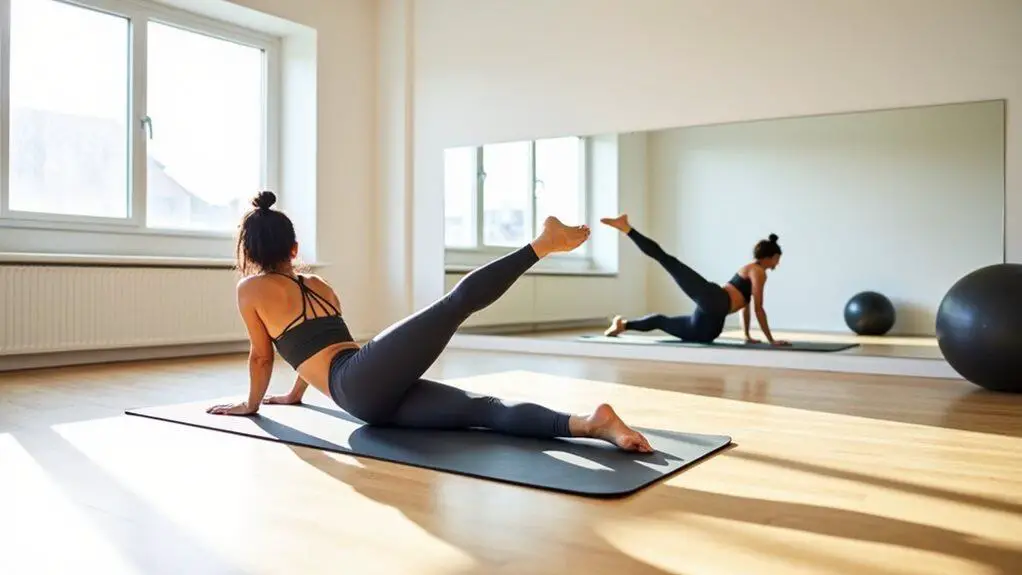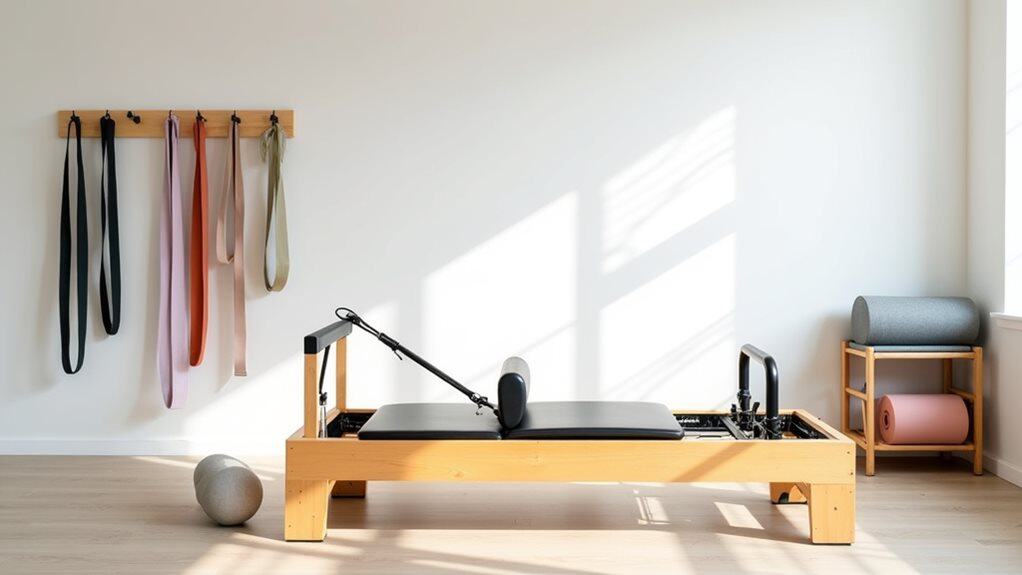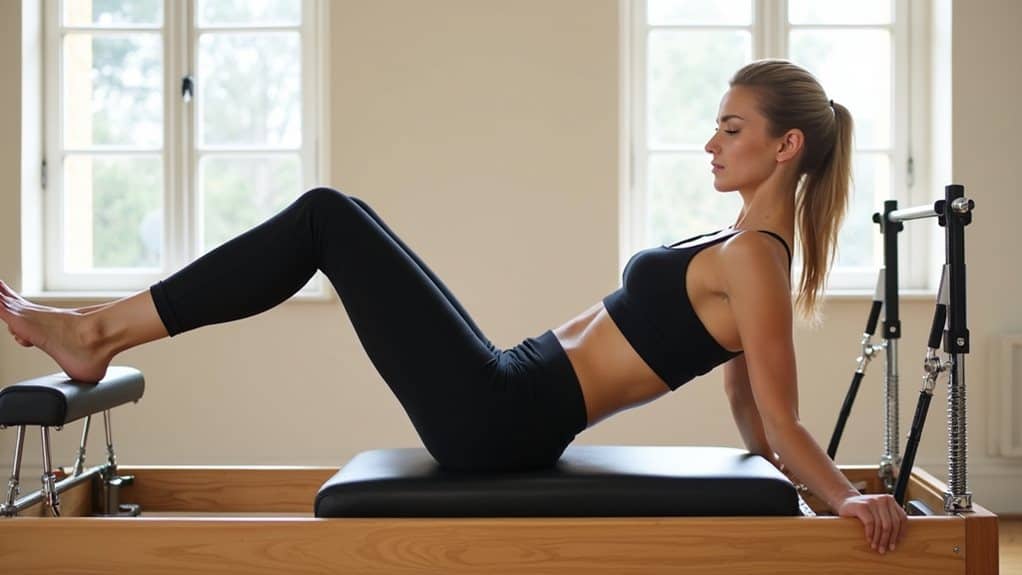In today’s fast-paced world, maintaining a balanced lifestyle can seem like an uphill battle. Between work, family, and personal commitments, it’s easy to neglect our health and well-being. However, finding a balance between our physical, mental, and emotional health is crucial for overall wellness. One way to achieve this balance is through Pilates.
Pilates is a form of exercise that focuses on balance, concentration, control, centering, breath, and fluid movements. But beyond being a physical exercise, Pilates can also contribute significantly to a balanced lifestyle. Here’s how:
- Physical Health: Pilates is a full-body workout that targets all muscle groups. It improves flexibility, builds strength, and enhances muscular balance. It’s also low impact, making it suitable for all ages and fitness levels. Regular Pilates workouts can help maintain a healthy weight, improve posture, and reduce the risk of injury, contributing to better physical health.
- Mental Health: Pilates is as much a mental workout as it is physical. It requires concentration and focus to perform the movements correctly. This focus can help clear your mind, reducing stress and anxiety. Additionally, Pilates encourages mindful movement – an awareness of your body and how it moves – which can improve your mental clarity and focus in everyday life.
- Emotional Well-being: Regular exercise, including Pilates, boosts your mood and promotes better sleep, both of which contribute to better emotional health. The mindful nature of Pilates can also help you feel more in tune with your body, leading to improved self-confidence and body image.
- Work-Life Balance: Pilates can be easily incorporated into a busy schedule. With classes ranging from 45 minutes to an hour, it’s an efficient workout that can be squeezed into a lunch break or done at home. Regularly taking time for Pilates can help you establish a routine, promoting a better work-life balance.
- Social Connection: Joining a Pilates class can also provide a sense of community. Regular classes give you the opportunity to meet like-minded individuals, fostering social connections that can contribute to a balanced lifestyle.
Pilates offers a holistic approach to health and wellness. It promotes physical strength, mental clarity, emotional well-being, work-life balance, and social connection. So, if you’re seeking a balanced lifestyle, consider rolling out a Pilates mat. Your body and mind will thank you.
Importance of achieving a balanced lifestyle
A balanced lifestyle is essential for overall well-being. It allows us to manage our physical, mental, and emotional health effectively. In today’s fast-paced world, finding balance can be challenging, but it is crucial for our long-term happiness and fulfilment. One effective tool for achieving balance is Pilates. In this article, we will explore the importance of a balanced lifestyle and how Pilates can help you attain it.
Living a balanced lifestyle has numerous benefits. It helps reduce feelings of stress and overwhelm, improves physical and mental health, enhances productivity, and promotes overall happiness. When we achieve balance, we create harmony in all areas of our lives, including work, relationships, self-care, and leisure activities. It allows us to allocate time and energy appropriately, leading to a more fulfilling and purposeful life.
Pilates as a tool for achieving balance
Pilates is a mind-body exercise system that focuses on core strength, flexibility, muscular control, and body alignment. It involves a series of controlled movements and exercises performed on a mat or specialized equipment such as reformers, chairs, and barrels. Pilates can be adapted to meet individual needs, making it suitable for people of all ages and fitness levels.
Physical balance: Pilates improves physical balance by strengthening the core muscles, including the abdominals, back, hips, and pelvic floor. These muscles play a crucial role in maintaining proper posture and stability during movement. As you practice Pilates, you’ll develop better body awareness and alignment, leading to improved balance and coordination.
Mental balance: Pilates is not just a physical exercise; it also emphasizes the mind-body connection. Through focused breathing and concentration, Pilates helps calm the mind, reduce stress, and promote mental clarity. The mindful nature of Pilates allows you to develop increased self-awareness and present moment awareness, fostering mental balance and emotional well-being.
Flexibility and mobility: Pilates exercises emphasize a full range of motion, promoting flexibility and mobility throughout the body. Improved flexibility reduces the risk of injuries, enhances joint health, and allows for greater freedom of movement. As you become more flexible, you’ll experience increased ease in everyday activities and a greater sense of overall physical well-being.
Achieving a balanced lifestyle is essential for a happy and healthy life. Pilates can play a significant role in helping you attain balance by strengthening your body, calming your mind, and improving flexibility and mobility. Whether you are a beginner or an experienced practitioner, incorporating Pilates into your routine can have a transformative effect on your overall well-being.
Incorporating Pilates into a Balanced Lifestyle
Pilates is more than just a workout; it’s a way of life that can help you achieve a balanced and harmonious existence. By incorporating Pilates into your daily routine, you can transform not only your physical health but also your mental and emotional well-being.
One of the key benefits of Pilates is its ability to improve body awareness and alignment. Through precise and controlled movements, you become more attuned to your body and how it moves. This increased body awareness extends beyond the Pilates studio and spills over into your daily life. You become more mindful of how you sit, stand, and move, making conscious efforts to maintain proper posture and alignment throughout the day.
Pilates also promotes a sense of balance by targeting all muscle groups evenly. Many traditional workouts tend to overemphasize certain muscles while neglecting others, leading to muscular imbalances. Pilates, on the other hand, focuses on strengthening the core, improving flexibility, and promoting overall body symmetry. This balanced approach not only enhances your physical capabilities but also reduces the risk of injuries and chronic pain.
As you incorporate Pilates into your lifestyle, you’ll notice a positive shift in your mental and emotional well-being. The mind-body connection fostered through Pilates helps to reduce stress, anxiety, and tension. The flowing and rhythmic movements, combined with focused breathing techniques, create a sense of relaxation and tranquillity. Pilates serves as a form of meditation in motion, offering a reprieve from the fast-paced and demanding nature of modern life.
Furthermore, Pilates encourages self-care and self-awareness. By committing to a regular Pilates practice, you are dedicating time to take care of yourself both physically and mentally. This act of self-care allows you to recharge, rejuvenate, and prioritize your own well-being. As a result, you become better equipped to handle the challenges and demands of daily life, finding a greater sense of balance and fulfilment.
To truly incorporate Pilates into a balanced lifestyle, it’s important to establish consistency and make it a part of your daily or weekly routine. Whether it’s attending group classes, working with a private instructor, or practising at home, creating a regular Pilates practice will yield the greatest benefits. Setting aside time for Pilates becomes a non-negotiable in your schedule, just like other important commitments or responsibilities.
By establishing clear objectives and tailoring your Pilates practice to your specific needs and aspirations, you can optimize your results and enhance your overall well-being.
- Setting Fitness Goals: Begin by identifying what you want to accomplish through your Pilates practice. Are you aiming to improve strength, increase flexibility, enhance posture, relieve stress, or all of the above? Be specific and realistic about your goals. For example, you might set a goal to improve core strength, increase overall muscle tone, or alleviate back pain.
- Assessing Your Current Fitness Level: Evaluate your current fitness level to gauge where you stand and determine the appropriate starting point for your personalized Pilates routine. Consider your flexibility, strength, and endurance. This self-assessment will help you identify areas that need improvement and guide you in selecting suitable exercises and modifications.
- Consulting with a Pilates Professional: If you are new to Pilates or would like expert guidance, consider consulting with a certified Pilates instructor. They can provide personalized guidance, assess your movement patterns, and help you set realistic goals for your practice. A qualified instructor will consider any physical limitations or medical conditions you may have and tailor your routine accordingly.
- Designing Your Pilates Routine: Once you have established your goals and sought professional guidance if necessary, it’s time to create your personalized Pilates routine. Adapt exercises and sequences to address your specific objectives. For example, if your goal is improving core strength, focus on exercises that target the abdominal and back muscles.
- Tracking Your Progress: Keep track of your progress by maintaining a workout journal or using fitness apps to log your sessions, exercises, and any improvements you notice. Regularly reassess your fitness goals and adjust your routine accordingly. Celebrate achievements, no matter how small, to stay motivated and inspired on your Pilates journey.
As you progress in your practice, consider incorporating a mix of Pilates equipment, such as reformers, stability balls, and resistance bands, to add variety and challenge to your routine. Vary the intensity and duration of your sessions, gradually progressing as you build strength and flexibility.
By setting clear fitness goals and creating a personalized Pilates routine, you can make significant strides towards achieving a balanced lifestyle. Consistency, dedication, and attentiveness to your body’s needs will help you reap the maximum benefits of Pilates both physically and mentally.
Remember to listen to your body and make adjustments as needed. It’s essential to strike a balance between challenging yourself and avoiding overexertion or injury. Rest and recovery are just as important as active practice to maintain a balanced lifestyle.
Finding a qualified Pilates instructor or studio
When it comes to Pilates, finding a qualified instructor or studio is crucial to ensuring you receive proper guidance and instruction throughout your practice. Here are some key steps to help you find the right fit:
- Research and gather information: Start by researching Pilates instructors and studios in your local area. Check online directories, read reviews, and explore their websites to learn more about their qualifications, experience, and teaching styles. Look for instructors who are certified by reputable Pilates organizations, such as the Pilates Method Alliance (PMA).
- Seek recommendations: Reach out to friends, family, or colleagues who have experience with Pilates and ask for their recommendations. Personal referrals can be highly valuable in finding an instructor or studio that meets your needs and preferences.
- Visit studios and observe classes: Once you have narrowed down your options, schedule visits to the studios you are interested in. Observe classes in action and pay attention to the instructor’s teaching style, professionalism, and ability to connect with students. Take note of the studio environment and equipment to ensure that it aligns with your preferences.
- Meet and communicate with the instructor: If possible, request a meeting with the instructor before committing to classes or sessions. This will allow you to discuss your goals, any specific health considerations or limitations you may have, and assess their level of knowledge and expertise.
- Inquire about qualifications and certifications: When speaking with the instructor, inquire about their qualifications and certifications. A qualified Pilates instructor should have completed a comprehensive training program and ideally hold certifications from reputable Pilates organizations. This demonstrates their commitment to continuing education and adherence to industry standards.
- Consider class size and individual attention: Depending on your preferences and goals, you may prefer either group classes or individual sessions. Ask about class sizes and how much individual attention each student receives during group classes. If you have specific needs or injuries, make sure the instructor can provide modifications and personalized guidance.
- Trust your instincts: Finally, trust your instincts and choose an instructor or studio where you feel comfortable, supported, and confident in their expertise. Pilates is a practice that requires trust and connection between the instructor and student, so it’s important to choose someone you feel you can truly rely on.
Remember, finding the right Pilates instructor or studio may take some time and exploration, but investing effort into finding the right fit will greatly enhance your Pilates journey and help you achieve a balanced and fulfilling lifestyle.
Combining Pilates with other forms of exercise is a great way to achieve a balanced and well-rounded fitness routine. While Pilates focuses on core strength, flexibility, and body alignment, incorporating other types of exercise can help target different muscle groups and add variety to your workouts.
Here are some examples of how you can combine Pilates with other exercises:
- Cardiovascular Exercise: Pilates is not a high-intensity cardio workout, so incorporating cardiovascular exercises like running, cycling, or swimming can help increase your heart rate and improve your overall cardiovascular health. You can schedule cardio workouts on alternate days or do shorter cardio sessions before or after your Pilates practice.
- Strength Training: Pilates strengthens and tones your muscles, but if you want to build more strength or target specific muscle groups, you can add strength training exercises to your routine. This can include using weights, resistance bands, or bodyweight exercises like push-ups, squats, and lunges. By combining Pilates with strength training, you can achieve a lean and sculpted physique.
- Yoga: Both Pilates and yoga focus on breath control, mindfulness, and body awareness, making them a natural combination. Incorporating yoga into your Pilates routine can enhance your flexibility, balance, and overall mind-body connection. Many fitness studios offer classes that combine Pilates and yoga elements, giving you the best of both worlds.
- Barre Classes: Barre workouts incorporate elements of Pilates, ballet, and strength training. These workouts typically include small, isolated movements that target specific muscle groups, such as the thighs, glutes, and core. Adding barre classes to your Pilates regimen can help improve your posture, tone your muscles, and increase stability.
- Mind-Body Exercises: Pilates and activities like tai chi and qigong share a focus on mindful movement and connecting with the breath. These practices can help improve balance, reduce stress, and enhance overall well-being. Incorporating mind-body exercises alongside your Pilates practice can offer a holistic approach to fitness and mental wellness.
When combining Pilates with other forms of exercise, it’s important to listen to your body and avoid overtraining. Be aware of your limitations and consult with a qualified instructor or trainer to ensure proper form and technique. Remember, finding the right balance between different exercises can help you achieve a well-rounded, balanced, and enjoyable fitness routine.
Importance of a balanced diet for optimal results
When it comes to achieving optimal results in Pilates, maintaining a balanced diet is crucial. A balanced diet provides the necessary nutrients, vitamins, and minerals that support your body’s overall health and fitness. It fuels your workouts, aids in recovery, and helps you achieve and maintain a healthy weight.
Nutrition plays a significant role in complementing your Pilates practice. First and foremost, it provides the energy needed to perform the exercises and sustain endurance throughout the sessions. A balanced diet rich in carbohydrates, lean proteins, and healthy fats ensures a steady supply of energy and supports muscle growth and repair.
Additionally, nutrition helps in enhancing flexibility and reducing muscle inflammation, which is beneficial for Pilates practitioners. Foods rich in antioxidants, such as fruits and vegetables, help combat oxidative stress and promote quicker recovery after intense workouts.
Moreover, proper nutrition supports overall body composition and body fat reduction, which can enhance the results of Pilates. It helps to maintain lean muscle mass while reducing excess body fat, resulting in a more sculpted and toned physique.
Tips for maintaining a balanced diet:
- Include a variety of whole foods: Incorporate a range of fruits, vegetables, whole grains, lean proteins, and healthy fats into your meals. This ensures you receive a wide spectrum of nutrients for optimum health and performance.
- Stay hydrated: Adequate hydration is essential for optimal bodily functions and helps maintain energy levels during your Pilates practice. Drink water throughout the day, especially before and after your sessions.
- Eat mindfully: Pay attention to hunger and fullness cues, and avoid mindless snacking. Be aware of portion sizes and take the time to savor and enjoy your meals.
- Prioritize nutrient-dense foods: Focus on nutrient-dense options like leafy greens, lean proteins, nuts, seeds, and whole grains. These foods provide essential nutrients while keeping calorie intake in check.
- Limit processed foods and added sugars: Minimize the consumption of processed foods, sugary beverages, and snacks. These foods can lead to energy crashes, inflammation, and hinder your progress in Pilates.
- Plan your meals and snacks: Prepare and plan your meals ahead of time to ensure you have nutritious options readily available. This will prevent impulsive food choices that may not align with your goals.
By maintaining a balanced diet that supports your Pilates practice, you will enhance your overall performance, achieve better results, and support a balanced and healthy lifestyle. Remember to consult with a nutritionist or dietitian for personalized guidance based on your specific needs and goals.
Creating Balance in Other Areas of Life – Pilates Can Help You Achieve a Balanced Lifestyle
In today’s fast-paced world, finding a balance between work and personal life can be challenging. The demands of work, family obligations, and daily responsibilities can leave little time for self-care and personal fulfillment. However, incorporating Pilates into your routine can help you achieve a better balance.
Pilates is not just a physical exercise; it is a mindful practice that promotes mental and emotional well-being. By committing to regular Pilates sessions, you carve out dedicated time for yourself, away from the demands of work and other responsibilities. During your Pilates practice, you can focus on your breath and mental clarity, allowing you to let go of stress and find inner peace.
Moreover, Pilates can help improve your productivity and effectiveness at work. By strengthening your core muscles and improving your posture, you’ll experience better body alignment and increased energy levels throughout the day. This will enable you to approach work tasks with more focus and efficiency, reducing the risk of burnout and enhancing work-life harmony.
Managing stress and prioritizing self-care
Stress is a common aspect of modern life, and it can have significant impacts on our mental and physical well-being. Pilates can be a powerful tool in managing stress and prioritizing self-care.
During a Pilates session, you engage in controlled movements and concentrate on each exercise, effectively switching off the outside world and giving your mind a break from stressors. The mindful nature of Pilates encourages relaxation, deep breathing, and tension release in the body, helping to reduce stress levels.
Furthermore, Pilates offers gentle stretching and strengthening exercises that help release tight muscles and alleviate physical tension caused by stress. The practice helps improve circulation, boosts endorphin production, and promotes a sense of well-being. By making Pilates a regular part of your self-care routine, you can proactively manage stress and enhance your overall quality of life.
Cultivating healthy relationships and social connections:
Building and maintaining healthy relationships and social connections is vital for a balanced and fulfilling life. Pilates offers an opportunity to connect with like-minded individuals, fostering a sense of belonging and camaraderie.
Attending group Pilates classes allows you to meet new people who share a common passion for health and wellness. Bonding over your shared experiences in class can lead to valuable friendships and a supportive network. Having a supportive community can provide a sense of belonging, accountability, and motivation to stay committed to your Pilates practice.
Additionally, Pilates can be a shared activity for couples or friends, providing a fun and interactive way to spend time together while prioritizing health and well-being. Working out together can strengthen the bond and create shared memories.
In summary, integrating Pilates into your life can help you achieve a balanced lifestyle. By balancing work and personal life, managing stress, and cultivating healthy relationships, Pilates becomes a holistic practice that not only enhances physical fitness but promotes overall well-being. Through Pilates, you can create inner harmony, find serenity amidst the chaos, and live a more fulfilled life.
Final Thoughts
Pilates offers a multitude of benefits that can help you achieve a balanced lifestyle. Throughout our discussion, we have explored the physical, mental, and emotional advantages of practicing Pilates regularly. By incorporating this holistic exercise program into your daily routine, you can experience improved strength, flexibility, and posture, enhanced mental clarity and focus, reduced stress and anxiety, and increased overall well-being.
Recap of the benefits of Pilates for achieving a balanced lifestyle:
- Physical benefits: Pilates focuses on strengthening the core muscles, improving flexibility, and enhancing muscular balance, leading to better posture, increased energy levels, and reduced risk of injuries.
- Mental benefits: Regular Pilates practice can boost mental clarity, concentration, and focus, improving cognitive function and overall brain health.
- Emotional benefits: Pilates promotes relaxation, reduces stress levels, and increases serotonin production, which can help alleviate symptoms of anxiety and depression, leading to a more balanced emotional state.
- Improved body awareness: Through Pilates, you will develop a deeper understanding of your body, its movement patterns, and alignment, allowing you to make conscious choices in your daily activities to maintain balance and prevent imbalances or injuries.
- Enhanced overall well-being: By integrating Pilates into your lifestyle, you can experience a sense of overall well-being and harmony throughout your body and mind.
Now that you are aware of the incredible benefits Pilates offers, I encourage you to take the first step towards incorporating it into your daily life.
It’s never too late to start, and even if you are a beginner, there are various resources available to help you learn and progress at your own pace. Whether you join a Pilates class, hire a certified instructor, or follow online tutorials, remember that consistency and commitment are key to reaping the benefits of this transformative practice.
So, why wait? Take that first step towards a more balanced lifestyle by incorporating Pilates into your daily routine. You deserve to experience the physical, mental, and emotional well-being that Pilates can provide. Start today and embark on a journey towards a more balanced and fulfilling life.




